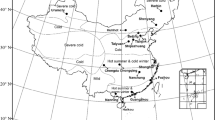Abstract
In order to improve the engineering applicability of on–off time–area method, this chapter first carried on tracing collection of existed building thermal measurement transformation users’ data of heating performance in Shijiazhuang and other three cities in the heating season 2010–2011. Then it brings up the empirical formula of opening ratio compensation factor. Combined with typical users’ heating data of practical engineering, the heat of all users has been calculated and shared again. Result shows that heat-sharing can reflect users’ real heat demand more accurately. To some extent, empirical formula of opening ratio compensation factor improved the accuracy and fairness of measurement. At the same time, it provides a theoretical basis for the applicability of on–off time–area method.
Access this chapter
Tax calculation will be finalised at checkout
Purchases are for personal use only
Similar content being viewed by others
References
Qi C, Wu J, Wang X (2003) Measurement and room temperature control of integrated intelligent heat meter. China: 03242120.6, 2004. 9.29 (Date of Application:2003.3.18)
Qi C, Gao J, Fang L et al (2004) New intelligent heat metering control system. HVAC 34(10):103–105
Gao Y (2006) Numerical simulation of influence of Step Changed Heat Source on indoor environment in a heating room. Hebei University of Technology, Tianjin
Zhang K (2009) Improvement of heating allocation method based on on–off value regulation mode of heat supply. Hebei University of Technology, Tianjin
Feng D (2010) Compensation factor of Q system used for residence building. Hebei University of Technology, Tianjin
Yang H, Chen D, Xia G et al (2011) Theoretical research of the accumulative open time ratio base on on–off valve regulation mode of heat supply. ICEE IV:364–367
Author information
Authors and Affiliations
Corresponding author
Editor information
Editors and Affiliations
Rights and permissions
Copyright information
© 2014 Springer-Verlag Berlin Heidelberg
About this paper
Cite this paper
Qi, S., Yang, H., Xia, G., Sun, C., Chen, D. (2014). Research on Improving the Engineering Applicability of On–Off Time–Area Method. In: Li, A., Zhu, Y., Li, Y. (eds) Proceedings of the 8th International Symposium on Heating, Ventilation and Air Conditioning. Lecture Notes in Electrical Engineering, vol 263. Springer, Berlin, Heidelberg. https://doi.org/10.1007/978-3-642-39578-9_58
Download citation
DOI: https://doi.org/10.1007/978-3-642-39578-9_58
Published:
Publisher Name: Springer, Berlin, Heidelberg
Print ISBN: 978-3-642-39577-2
Online ISBN: 978-3-642-39578-9
eBook Packages: EngineeringEngineering (R0)




